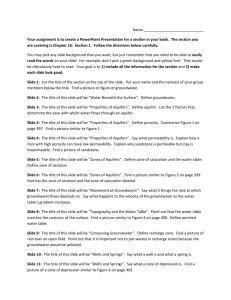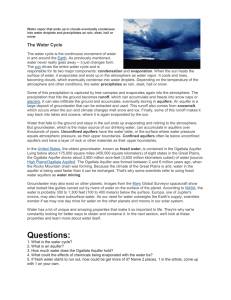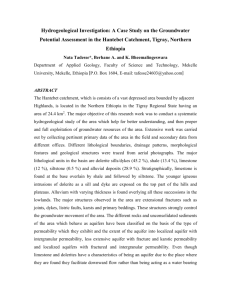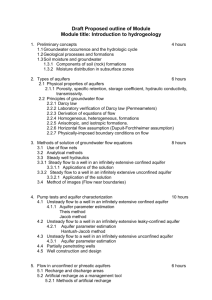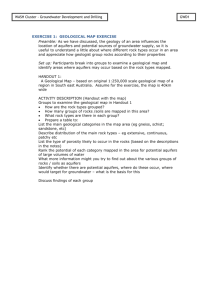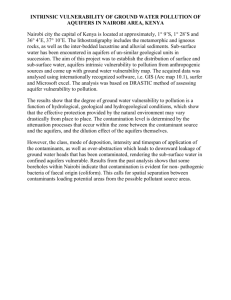Groundwater in Michigan by Mattox and Prough
advertisement
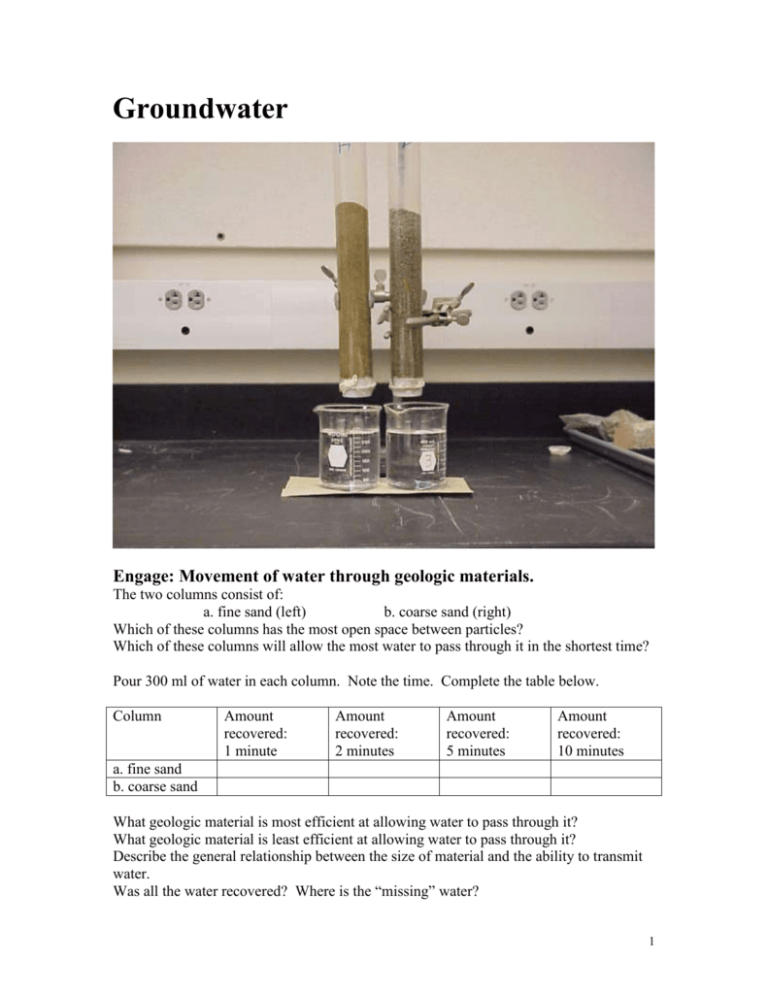
Groundwater Engage: Movement of water through geologic materials. The two columns consist of: a. fine sand (left) b. coarse sand (right) Which of these columns has the most open space between particles? Which of these columns will allow the most water to pass through it in the shortest time? Pour 300 ml of water in each column. Note the time. Complete the table below. Column Amount recovered: 1 minute Amount recovered: 2 minutes Amount recovered: 5 minutes Amount recovered: 10 minutes a. fine sand b. coarse sand What geologic material is most efficient at allowing water to pass through it? What geologic material is least efficient at allowing water to pass through it? Describe the general relationship between the size of material and the ability to transmit water. Was all the water recovered? Where is the “missing” water? 1 Explore: 1. Finding Water The figure on the next page is a map of aquifers, water-bearing units, of Michigan. Each aquifer is shown in a different color. Use the map legend below to identify each aquifer in Marquette County. a. ___________________________ b. ___________________________ c. ___________________________ d. ___________________________ For each of the aquifers that you identified above determine the common types of rocks it contains (shale, limestone, sandstone, etc.). You will need to use the hydrogeologic units chart. a. ___________________________ b. ___________________________ c. ___________________________ d. ___________________________ Aquicludes are rock units that do not permit water to flow thorough them. They are also called confining units because confine the water to water-rich aquifer layers. Use the stratigraphic column to identify the confining units in Marquette County. What rock type is most common as an aquiclude? (shale, limestone, sandstone, dolostone, etc.). Circle your answer. 2 3 4 This figure shows a cross-section of the aquifers in the Michigan Basin. In general what direction do the layers slope from Marquette County to the center of the Lower Peninsula? In what direction does the groundwater flow? How do the rocks in this cross-section relate to the rocks in Marquette County? (Refer to the lesson on Rocks of Michigan if needed). 2. Where does the water in Marquette County come from? Visit the EPA’s Watershed page (http://cfpub.epa.gov/surf/locate/countyperstate_search.cfm?statepostal=MI) and click on Marquette County. Click on one of the basins in Marquette County. a. What is the name of the basin? b. What are the main aquifers? c. What geologic material is the aquifer made of? Return to the web page and click on the following: (Water use (1990): Information about the amount of water used and how it is used) Answer the following questions. d. Is more groundwater or surface water used in this basin? e. List the uses of groundwater in this basin. 5 3. Water movement in shallow aquifers. Geologists have identified two different kinds of aquifers. One is common in the glacial materials that blanket the surface in Michigan. The other is found in the rock layers at greater depths (as shown in the rock stratigraphic columns). This jar of sand is a simple model for one of the most important types of aquifers in Michigan. 1. What holds the sand in place (what confines the sand)? 2. Is the pore space between the sand grains they same everywhere in the jar? Describe any differences. 3. What factors influence the water level in the jar? 4. If you “drilled” into the sand with a straw how deep would you need to go to reach the aquifer? 5. Geologists call the boundary between water filled pores and air filled pores the water table. Indicate on the jar where the water table is in this simple system. 4. Water movement in deep aquifers. The diagram below shows a cross-section of a deep aquifer. The water-bearing layer is sandwiched between two impermeable layers (layers that don’t let water through), commonly shale. The water might be in a sandstone. 6 Set up a model of a deep aquifer as shown above. The walls of the plastic tube represent aquicludes like clay or shale. The open tube represents the confined permeable layer that contains water, a sandstone. Pour water into the model until about half full. 1. Elevate the end of the thick tube that represents the open end of the aquifer. Does the level of the water in the well (thin vertical tube) increase or decrease? 2. Repeat by lowering the open end of the tube. Does the level of the water in the well increase or decrease? 3. Can you raise the tube to make water flow out of the well? Describe the conditions (make a drawing if needed). 4. What is the major influence on the level of the water in the well? 5. For real aquifers how do you think water is added to permeable rock layers? 7 Explain: Porosity and permeability are two important characteristics in rocks that influence how water moves through them. Porosity is the percentage of a rock’s volume that is taken up by openings. Permeability is the capacity of a rock to transmit water. For example, sand, gravel, sandstone, and cavernous limestone have high porosity and permeability. They make good aquifers. Glacial till, clay, granite, metamorphic rocks, and shale have lower porosity and permeability and tend to make aquicludes. The water table is the upper surface of the saturated zone (the zone where spaces between grains are filled with water). The water table meets bodies of water at the surface at lakes and rivers. Diagram courtesy of U.S. Geological Survey (Circular 1139). Aquifers are bodies of saturated rock or sediment through which water can move readily. Aquicludes are bodies of rock or sediment that do not allow water to move readily through them. The slope of the watertable tends to follow the slope of the land surface. In an unconfined aquifer flow paths are shallow arcs that move the water towards rivers and lakes. Water in confined aquifers can also take curved paths that eventually (after centuries of years) reach the surface. Diagram courtesy of U.S. Geological Survey (Circular 1139). 8 Typical groundwater flows paths in glacial and dune areas. Note that lakes and wetlands at higher elevations recharge the groundwater at lower elevations. The source of water in an unconfined aquifer is rainfall. Rainfall is also the source of water in confined aquifers. Diagram courtesy of U.S. Geological Survey (Circular 1139). Humans can influence aquifers in many ways. Overpumping of water causes the surface of the water table to be lowered adjacent to wells. In three dimensions, the water table forms a funnel-shaped feature called a cone of depression. In some cases the cone of depression can cause the local groundwater to change flow direction. Diagram courtesy of U.S. Geological Survey (Circular 1139). Contamination of aquifers can occur when pollutants seep into the groundwater. These pollutants can be from point sources (leakage from underground storage tanks, sewage plants) or nonpoint sources (fertilizers, pesticides). Diagram courtesy of U.S. Geological Survey (Circular 1139). 9 Apply: 1. Finding Water In Your County. Return to the maps and figure in Explore 1. How many aquifers are there in your county? Each aquifer is shown in a different color. Use the map legend to identify each aquifer in your county. a. ___________________________ b. ___________________________ c. ___________________________ d. ___________________________ e. ___________________________ For each of the aquifers that you identified above determine the common types of rocks it contains (shale, limestone, sandstone, etc.). You will need to use the hydrogeologic units chart (see Explore 1). a. ___________________________ b. ___________________________ c. ___________________________ d. ___________________________ e. ___________________________ 2. Where does the water in your county come from? Visit the EPA’s Watershed page (http://www.epa.gov/iwi/counties/) and visit one of the basins in your county. a. What is the name of the basin. b. What are the main types of aquifers. c. What geologic material is the aquifer made of? Return to the web page and click on the following: (Water use (1990): Information about the amount of water used and how it is used) Answer the following questions. d. Is more groundwater or surface water used in this basin? e. List the uses of groundwater in this basin. 3. Identifying the Aquifers and Aquicludes of Michigan The diagram on the next page shows the rocks layers in Michigan. Based on what you know about rocks and their characteristics how many aquifers are there in Michigan? Label them with “A”s. How did you define your aquifers? Compare your results with your classmates. Compare your results with the chart in Explore 1. 10 4. Types of Aquifers in Your County Draw a cross-section of the rocks beneath your county. Show aquifers and aquicludes. You may want to refer to the Geologic map of Michigan and the Quaternary Map of Michigan. Label any confined and unconfined aquifers. Inquire Further: 1. Protecting Water Resources Which type of aquifer is more susceptible to contamination from a leaking underground storage tank, a confined or unconfined? Explain your answer. 2. Careers in Geology Geologist report high job satisfaction. Cinda Crabbe MacKinnon is a hydrogeologist that has had a diverse career and now runs here own company. Read about Cinda at the Association for Women Geoscientists website (http://www.awg.org/eas/profiles.html). Additional Information: 1. Information on water quality in Michigan can be found at the U.S. EPA webpage at http://iaspub.epa.gov/waters10/w305b_report_v2.state 2. An excellent resources is: Ground Water And Surface Water: A Single Resource by T.C. Winter, J.W. Harvey, O.L. Franke, and W.M. Alley U.S. Geological Survey Circular 1139. http://water.usgs.gov/pubs/circ/circ1139/ 11


